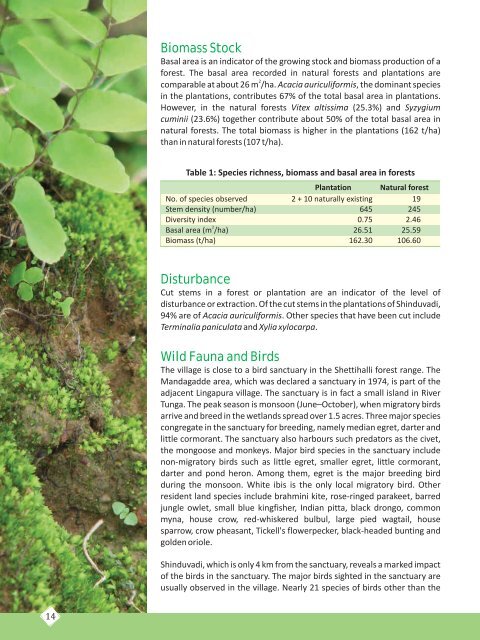2007 - Centre for Ecological Sciences - Indian Institute of Science
2007 - Centre for Ecological Sciences - Indian Institute of Science
2007 - Centre for Ecological Sciences - Indian Institute of Science
- No tags were found...
Create successful ePaper yourself
Turn your PDF publications into a flip-book with our unique Google optimized e-Paper software.
Biomass StockBasal area is an indicator <strong>of</strong> the growing stock and biomass production <strong>of</strong> a<strong>for</strong>est. The basal area recorded in natural <strong>for</strong>ests and plantations are2comparable at about 26 m /ha. Acacia auriculi<strong>for</strong>mis, the dominant speciesin the plantations, contributes 67% <strong>of</strong> the total basal area in plantations.However, in the natural <strong>for</strong>ests Vitex altissima (25.3%) and Syzygiumcuminii (23.6%) together contribute about 50% <strong>of</strong> the total basal area innatural <strong>for</strong>ests. The total biomass is higher in the plantations (162 t/ha)than in natural <strong>for</strong>ests (107 t/ha).Table 1: Species richness, biomass and basal area in <strong>for</strong>estsPlantation Natural <strong>for</strong>estNo. <strong>of</strong> species observed 2 + 10 naturally existing 19Stem density (number/ha) 645 245Diversity index 0.75 2.462Basal area (m /ha) 26.51 25.59Biomass (t/ha) 162.30 106.60DisturbanceCut stems in a <strong>for</strong>est or plantation are an indicator <strong>of</strong> the level <strong>of</strong>disturbance or extraction. Of the cut stems in the plantations <strong>of</strong> Shinduvadi,94% are <strong>of</strong> Acacia auriculi<strong>for</strong>mis. Other species that have been cut includeTerminalia paniculata and Xylia xylocarpa.Wild Fauna and BirdsThe village is close to a bird sanctuary in the Shettihalli <strong>for</strong>est range. TheMandagadde area, which was declared a sanctuary in 1974, is part <strong>of</strong> theadjacent Lingapura village. The sanctuary is in fact a small island in RiverTunga. The peak season is monsoon (June–October), when migratory birdsarrive and breed in the wetlands spread over 1.5 acres. Three major speciescongregate in the sanctuary <strong>for</strong> breeding, namely median egret, darter andlittle cormorant. The sanctuary also harbours such predators as the civet,the mongoose and monkeys. Major bird species in the sanctuary includenon-migratory birds such as little egret, smaller egret, little cormorant,darter and pond heron. Among them, egret is the major breeding birdduring the monsoon. White ibis is the only local migratory bird. Otherresident land species include brahmini kite, rose-ringed parakeet, barredjungle owlet, small blue kingfisher, <strong>Indian</strong> pitta, black drongo, commonmyna, house crow, red-whiskered bulbul, large pied wagtail, housesparrow, crow pheasant, Tickell's flowerpecker, black-headed bunting andgolden oriole.Shinduvadi, which is only 4 km from the sanctuary, reveals a marked impact<strong>of</strong> the birds in the sanctuary. The major birds sighted in the sanctuary areusually observed in the village. Nearly 21 species <strong>of</strong> birds other than the14
















